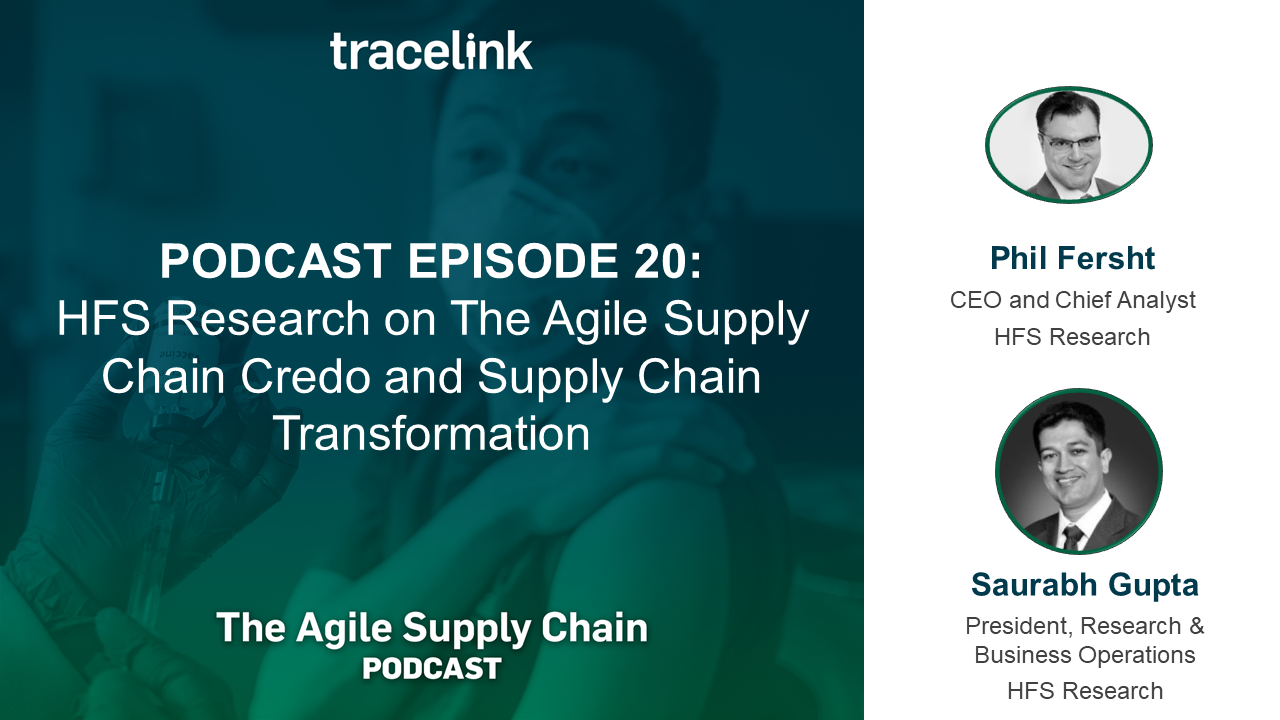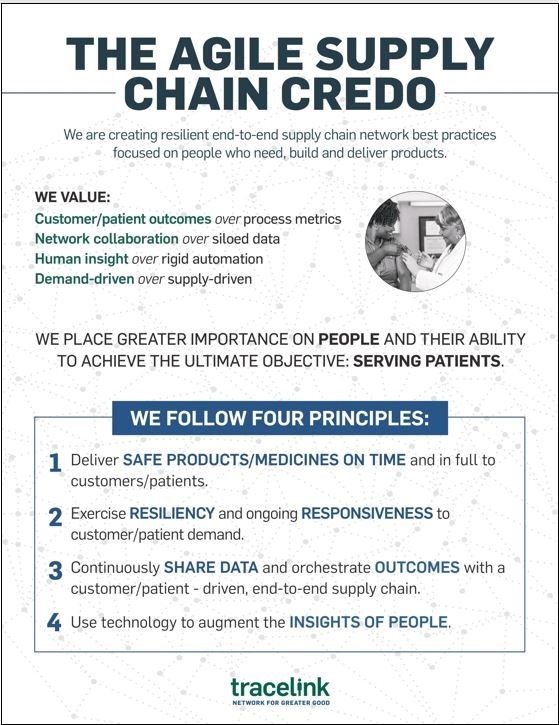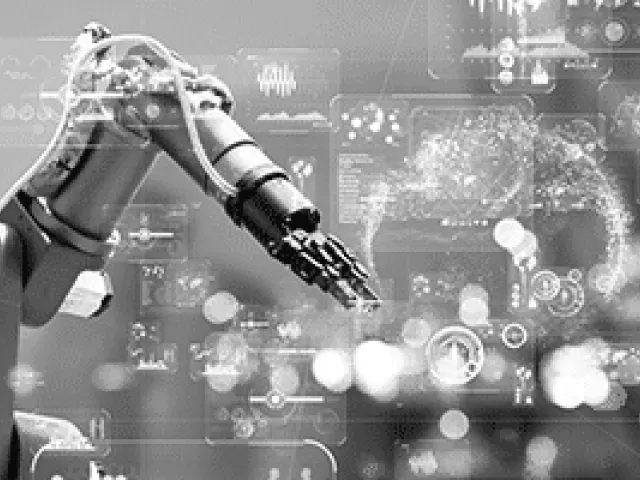Table of contents
Key Takeaways
-
One of the key principles of The Agile Supply Chain Credo is patient-centricity, and that’s all about moving away from using inventory as an insurance policy and focusing on patients’ needs and dispenser-level data to get an accurate picture of demand.
-
Some of the biggest challenges facing life sciences companies today include ensuring global supply chain visibility, increasing speed to market, and adapting to new ways of working in the age of COVID-19.
-
To be a successful supply chain leader in the COVID-19 era and beyond, you must embrace digital transformation and become a true proponent of change. You need to be someone who is willing to move fast and get things done.

Your supply chain organization can purchase the most cutting-edge tools and technologies, but if it fails to create a competency framework that also includes people, processes, data, and change management, those investments will likely prove ineffective, according to HFS Research's Phil Fersht and Saurabh Gupta. In this episode of The Agile Supply Chain Podcast, Gupta and Fersht discuss the implications of The Agile Supply Chain Credo and explain what their extensive research tells us about how to carry out a successful supply chain transformation.
Transcript:
Phil Fersht and Saurabh Gupta of HFS Research discuss The Agile Supply Chain Credo and offer actionable advice on how to carry out a successful supply chain transformation, right now on "The Agile Supply Chain Podcast."
Roddy Martin: Phil and Saurabh, welcome. It's a pleasure to have you on the next shoot of one of our thought leadership series, where we've been talking to industry thought leaders, practitioners around, the impact of Agile in particular, and to discuss this Agile Supply Chain Credo that we came up together with the industry.
It's technology and vendor agnostic and it is a lot of common sense about how the healthcare supply chain needs to be focused. The interesting aspect of that is Agile. While it may have grown up in software, it was quite quickly adopted into the operations world for supply chain and lien and world‑class manufacturing. I think it's just different lenses looking at exactly the same issues.
How do we focus on the outcome, focus on the patient in this particular sense? Let me ask each of you to introduce yourself, talk a little bit about the HFS organization, Phil, that you've started, and your life sciences work. Over to you. Let's start with Phil.
Phil Fersht: Thank you, Roddy. First, I'm the founder, chief analyst here at HFS. I've been an analyst for about 17 years and a consultant for 3. I prefer talking about this stuff and actually doing it. I'm an analyst today, enjoy it very much. I shared the pleasure of working with you Roddy about 10 years ago now, I believe. Looking forward to becoming part of this conversation.
I've had some involvement in life sciences, largely through family connections. My father was a well‑known protein engineer back in the day, Professor Alan Fersht of Cambridge. He's just retired. I did some work in my earlier years on Bio‑IT and sequencing, and some of the processing issues in bioinformatics areas around the industry.
I've always kept fairly close to what's going on in the space and understanding this whole healthcare value chain from retail right through to the pharma companies and the drug discovery cycle. That's an area of interest. I also look very closely at areas like automation and AI and obviously digital in our research focus.
Roddy: Fantastic. It's interesting that you talk about your background and your first day's contact and your father in the industry. The industry has been a laggard for such a long time. It's confronted with such massive change in the pandemic, and second of all opportunities in challenging therapy, that there's this massive opportunity to leapfrog into the future.
All the elements are there, it's just the burning platform and the leadership to make it get there. Saurabh, how about you?
Saurabh Gupta: Thanks, Roddy, for having me here. I'm the chief research officer at HFS. I lead our research and advisory services, working closely with Phil. I've been in this industry for close to two decades in various roles.
I started as a software engineer doing programming, then realized I wasn't very good at it, so became a consultant where I advised a number of life sciences, and healthcare companies as well as other industry folks on things around global services, ID services, business process services. I spent a bunch of time with a biopharma company, here in Chicago called AbbVie.
I called them about $25 billion startup because they had just got out of Abbott Labs and were trying to find their feet on operating on their own. I was responsible for doing a bunch of third-party services for them from finance and accounting, to things like pharmacovigilance, transparency, along with ID services.
Now, I'm here with HFS, basically writing about everybody else and analyzing them. We truly believe that this pandemic shock has created that burning platform, Roddy, that you just articulated, to implement digitalization.
What's also interesting is that we are entering into a recessional economy. How do you marry those two things? On one hand, you need to actuate digitalization across supply general across practically every part of your business. At the same time, you have to do a lot more with a lot less. That's an interesting dynamic to deal with.
Roddy: Fantastic. We spoke about the Agile Supply Chain Credo, which really focused on technology Venn diagnostic model of good practices in the industry. Phil, as the chief research officer of HFS, and I've always known you to be the authoritative analyst on outsourcing IT services, platforms, managed services, etc. What pops out at you in the credo sense?
It's perhaps an unfair question, given your background because you were steeped in the industry so early. What pops out at you and what do you think the challenges are to the industry in reaching some of those aspirations?
Phil: I told you very specifically now about COVID and what's going on in the current predicament because that's obviously changed things quite differently from before. From the perspective I have, in some instances, this has created a whole new platform for life sciences and healthcare in terms of the attention it's getting, money that's being pumped into the industry.
I have friends in companies like Deloitte, Accenture, and some of these consulting firms who are licking their lips with money they're making right now. Working with these companies on dealing with very fragmented supply chains. Using funding to help advance track and trace apps, obviously vaccine works, and things like that.
In many respects, it's put the industry in a big spotlight. Investments being pumped in, and this could be a positive rather than a negative in longer term because this might not be our first pandemic, God forbid, there are more coming. We never saw this. In that respect, it's created some excitement on the challenge side, it's massive.
Obviously, supply chains are fragmented. It's hard to know how they get inventory in and out of countries. Understand what's open and what's not. Regulations, government cooperation, things like that. It's a very fluid current chaotic scenario that you need to be on top of. You need to be very current. You need to have very strong data.
You have people around you who really know what they are doing. On top of that, you've got, if not all of your staff working from home, some in labs who are essential workers and things. The challenges are massive. It's the same and obviously every industry right now is facing big, big challenges.
At least with life sciences the positive is, there's an interesting direction for them to go as we get into the next year and beyond, and how to make this all happen, but even this thing like vaccine distribution. I was reading about the fact that they need a certain level of refrigeration for vaccine distribution. You can't do this through your CVSs and these things.
You're going to have to turn the whole infrastructure as well for that to happen next year and obviously many other things to consider. It's chaos, it's potentially exciting chaos. It's an area that requires a lot of thoughts and investment in the things that are critical. You need a very strong backbone to analyze the current situation and stay ahead of it.
Roddy: Saurabh, you've worked in a life sciences company. When I say patient‑centric, I can remember once I was working with a big biotech company. I said to the head of tech-ops, I said, "We're doing this big supply chain transformation. Let's bring in the idea of patient‑centric."
He said, "Roddy, no, no. We're not ready to think" ‑‑ this is about five years ago ‑‑ "We're not ready to think like that. Let's not confuse the business." One of the essential cornerstones of that Agile Supply Chain Credo is the fact that it is about patient‑centricity.
It's about moving away from insurance policy‑based inventory levels to patient‑centeredness. To being able to respond fast to events, to be able to sense those events. Using systems to augment people's decision-making processes, not to replace them.
How would you comment about what pops out at you and any aspects that you want to talk about as big opportunities, major challenges, Saurabh?
Saurabh: I wholeheartedly agree that patient‑centricity or more broadly even consumer‑centricity because not everybody is going to be a patient in the healthcare. We need to be shifting the conversation from illness to wellness in a lot of different ways. Consumer‑centricity is a huge part of this. I believe that we've been talking about this industry as a B2B industry. It's actually becoming a B2C industry in a lot of ways.
If you look at, for example, medical devices, they are essentially becoming data companies. If you look at a diabetes pump, for example, imagine the amount of data that these companies are gathering, social data, behavioral data from the patient.
One part of it is that you need to be adaptable and responding to the customer needs. There's also another angle that you can actually monetize the data that you have and create different business models around this. Even if you look at pharma companies, there are these combo devices that are coming up.
It's no longer just a pill or a drug. It needs to be injected or it needs to be pumped into your body. The devices and the pharma industry is also converging. It definitely is a huge challenge. Most people do realize that they need to be consumer‑centric. It's not a slam dunk credit. It's very complicated and it's become even more complicated now after this pandemic shock.
We did a survey, Roddy, of a large number of global 2,000 organizations where there were about 40 different life sciences companies who participated there. There were these top three challenges that emerged.
Number one was supply chain, which has been tremendously impacted. Basic things like how many APIs are coming from China, you don't have visibility into that. How do you deal with that?
The second piece that's concerning life sciences is speed to market. You can have broad speed projects here for, let's say, COVID‑19 vaccinations. What happens to all the other drugs that were in that little time window of getting approved? Those things have been slowed down. Overall, speed to market has been impacted.
Then the ways of working. How do you do research and development and how do you do all these things working from home? It's super challenging. I completely agree with the credo that consumers or patients have to be front and center of this thing.
We've been talking about the one office for now four or five years, which basically talks about that this whole thing about front office, middle office, back office, is crap. There's only one office that matters and that's the office that caters to the patient or the consumer. At the same time, it's a very hard thing to do.
The conversation has to now start to move on. How do we get there? The why is pretty well‑understood and if somebody doesn't understand why you need to be patient‑centric, then you need to really not be in this industry.
Roddy: I'm going to talk to something that is, near and dear, to Phil's thought because I've watched a lot of his posts around RPA, and around AI, etc. This industry is still very gun shy about making the pivot to completely looking at the business from the outside.
Looking at patient usage, patient data, patient demand, and then translating it back into the supply chain because 10, 15 years ago there were some massive multi‑billion dollar fines that were handed out to some big pharmaceutical companies because of them inadvertently using patient data for the wrong stuff.
However, if we look at AI, machine learning, RPA, etc., we can start using that data in models and algorithms to provide much better visibility and call it segmentation, call it characteristics of demand, call it segments of patients. Using that data to do what the Credo calls for and that is use those models and those systems and those analytics to augment people's decision-making capabilities.
Instead of making 300 days’ worth of inventory and stuffing it everywhere and hoping that patients are going to get it, now you can understand where exactly do we need to have this product and how much do we need. Of course, there's always safety factors.
Let's go to the subject, AI, RPA, machine learning. How real do you think it is in this industry that's traditionally so conservative in IT? Do you think they're ready to take a step into the future, Phil?
Phil: They are being forced to, more than ever. In many cases they have no choice. RPA is a very useful tool for working around legacy systems and getting them to work with each other using various fairly old technologies, by the way, to electronically digitize workflow. It gets data moved around the company better. It's used fairly reactively.
It's used, for example, the NHS in the UK. They use RPA to take paper documents from doctor surgeries, scan them, and it automatically puts them into the green screen mainframes and moves that data along. It moves things along, it's a quick fix. It does have a place.
The problem with it is it's not fully industrialized yet. IT is not familiar with it, and it's hard to implement in many cases. It is very useful, and it can really help with some fairly rudimentary task‑based activities. When you look at what's happening right now where we are shifting into a very aggressive live‑from‑anywhere model.
It's live‑from‑anywhere, work‑from‑anywhere. You've got to move a lot of stuff into the cloud that we haven't done in a decade. A lot of the conversations over the last decade have been put aside while global organizations, they're making this pivot into the cloud as aggressively as they can.
What's happened in this pandemic is most companies have been forced to make some rudimentary transformation with their processes to get this functioning in a remote environment. It's for many businesses including life sciences firms, it's the first time in decades that they have be forced to look at their processes, which are completely antiquated and align with where they want to be.
Ultimately, they need to design the processes in a way that fulfills the business needs, fulfills the outcomes they want whether it's patient‑centricity or not. They need to redesign processes.
If you're moving everything to the cloud, you have to automate them. Automation is not a strategy, Roddy. It's something that is a native attitude. It's something that you have to do. It's not, are we going to do automation now? It's going to be the next big thing.
Now, if you don't automate your processes, you can't move everything into the cloud. You can't run your work digitally. AI comes into play once you've automated processes. You can orchestrate them using clever tools and technology and machine learning to do that. It's a sequence of activities that needs to take place.
It's redesign, automate,, and then you move it into the cloud as you start to look at your opportunities next. That's a path everybody's having to go through. You look at the platforms that are now popular amongst businesses. It's larger broader platforms.
Things like Microsoft Azure and you've got the Amazon products, you've got the IBM products, you've got all these platforms now, ServiceNow, for example, where they're starting to integrate processes together, they're starting to bring us together in a platform, because decisions are made high up the value chain.
They need a platform to run them off. A lot of this depends on what will do the job. It's not necessarily best of breed anymore, it's just what will work, what will move them fast, and how it's going to happen.
There's a massive change going on, at the executive level in terms of, you need to be a proponent of change today. You have to be somebody who's willing to move fast, cut a few corners, get things done. When you look at some of the results of some of the service providers right now, they're growing their businesses this year.
It's incredible looking at some of the financial performances of these businesses, because these enterprises have no choice but to bring in help to do it. We are blessed to be in the technology industry right now, Roddy. Absolutely blessed that when technology services business.
Roddy: Well, let's hope the wave keeps on rolling for a while. I think you make a great point because, for as long as I can remember, all of the major pharmaceutical companies just to pick on pharma, selected your favorite German ERP system is the cornerstone of everything that they did.
We all know the disadvantages of ERP. It's point‑to‑point, it's multiple replications of data, there's multiple versions of the truth. Building a business that has a 2 to 300‑day insurance policy of inventory out there to make sure a patient gets everything.
That was OK, after spending anywhere from one to three billion dollars on your ERP investment. That's not going to cut it for the future, especially as patient communities get more segmented. We've got to be a lot more refined on the patient side of the supply chain because as CVS or Walgreens or Boots, they're all popping up as alternative points of dispensaries in the future.
It's no longer just hospitals, it's no longer just doctors. It's now retail pharmacies, it's clinics, and all of the above. Let's talk a little bit about how does this impact the IT organization? How is it impacting them?
Phil: I can start this and then I will ask them to join in. It's changing the way we are consuming technology, and this is happening right here, right now. Our behavior is shifting very quickly. The way that we need to look at processes is changing right now. Applications are shifting as well. Things that were built for the era before this might no longer be that relevant.
I can't tell you how many ERP projects are currently on hold. They're just, "Let's not finish that now. We have other priorities in place." New priorities are now hitting organizations very hard. They're looking at quicker pivots, getting things done faster. I've seen projects that were eight months being reduced to three weeks in certain instances.
At this speed, this rapidity, it's changing things. Also how we're consuming technologies is shifting as well in terms of how do we need to use...Obviously, video technology is now incredibly important and will still be important when COVID eventually goes away which could be another year or so. How do we leverage that more effectively?
The other thing which is really starting to become important is, we're seeing a mingling of consumerization and personal technology with business technology. How do we start to blend our personal lives with our business lives? That is a challenge that we've never had at this scale. It's a massive security issue.
I'm amazed that security isn't the number one topic right now discussed. It's seems to be always brushed away somewhere. The amount of exposure not just to businesses, but to us personally now. You're using the same laptop for managing your AMEX repayments as your Zoom calls with Roddy or something.
You're potentially exposing yourself to a hacking activity with no on trace AI or HFS today. There's a lot of stuff that's changing in the way that we're consuming and using technology. It's harder to get in front of people and their machines and their applications to look at this stuff and observe this stuff.
You need more sophisticated monitoring apps. You need more sophisticated supply chain apps. You need to start to think about what works more effectively in this type of environment to make things operate.
There's a lot of work in progress. There's a lot of figuring it out. The number one areas that we're being asked about is, what are the applications in the future that are evolving from this scenario because this is happening right as we talk. The needs are changing. We're seeing new issues crop up. New needs happening all the time. We're all figuring this out.
Roddy: That's very interesting. Saurabh, if you can add anything to what Phil said. Then what I'm going to ask as we close out is if you could, each of you, give us a stop and a start that you think would be useful advice to any one of the listeners that are ultimately going to participate in this. Saurabh, what would you add to what Phil said?
Saurabh: Phil is bang on. I will add that, if you look at the challenges for implementing technology. The challenges are not about technology itself. The challenges are about mindset. The challenges are about culture. The challenges are about process. The challenges are about people. The challenges are about getting the right business case.
It's about getting the sea level commitment. It's not about the technology is poor. The oldest competency framework that we had, Martin, from for down these years is that people, process, technology framework. Imagine this was a Venn Diagram with three equal circles and the emphasis is on equal.
What has happened is that technology circle has become really big, but the people and process have shrunk. Nobody's paying importance to that. Technology has just overpowered the narrative. You can throw as much technology at it, but till you are solving for some of the other challenges that are associated with it. Take people, take process, take data.
You can have the best algorithms, the sexiest stuff out there, but if your data is crap, what do you do with it? Take change management. You can be the best in terms of investing loads of money on emerging technologies. If you don't have a robust change management program, it's of no use.
The only thing that a lag to what Phil said was, technology for the sake of technology doesn't work. We can talk about not just AI and automation and analytics but take block chain or IoT or even quantum computing. Till you solve for that competency framework of people, process, technology, and throw in data and change management at it, you're going to keep running in circles.
Roddy: You actually leave an interesting visual behind in my head that is, that there's this big circle called technology and actually the people, the process, and the leadership circles are inside the technology circle. It's not a Venn Diagram anymore. It's a very different way of thinking from the way we used to think in the past.
Very quickly as we close out, Phil, if you could succinctly define up an insightful stop and an insightful start and then I hand over to Saurabh, and then we'll call it a day.
Phil: This isn't like 2008, where we had a crash. We came back and we ran back to the same old habits that were before because this is truly an endemic change. We've already gone through some of that but it's going to get deeper as we go through a tough winter and probably a tough start to next year.
Hopefully, we'll see a new dawn emerge from this. We have to adapt. We have to accept the fact that things have changed and will change forever. We need to change within ourselves to get ahead of this and that means we need to figure out how to be more digitally fluent.
Which means if we're an operations executive, we need to learn a bit about how database schemas look, how types of IT setups work more effectively to support our business needs. If you're on the technology side, you need to understand business context.
We've been talking about this for decades, but this is the time where it truly, that interplay comes together. I call it digital fluency. You need to get ahead of this. You need to be proactive. You need to learn about this stuff. You need to stay as positive as you can because we're all a little jaded after months and months of this. We have to keep plowing on realizing we're only halfway through this and this will eventually fade away.
There will be some tremendous opportunities at the back end. We need to stay focused and keep learning. We've got no right to stop learning. Right now, we need to be thinking more than ever about how do I work with this? What can I do to be successful here? How can I think about what works better in this type of scenario?
Let's embrace this. Let's embrace change and really embrace the people around us to do that.
Roddy: This is a get out of your ostrich gig. Stop trying to recreate the past, it's never going back there. Start being digitally fluent for the future. That's great advice because there's tons of little digital experimental projects going on all around in many of these companies. They're not systematically focused on building new capabilities in the business.
Saurabh, what would you say are your stops and starts? What's stopping us?
Saurabh: I'd say it's time to start slaying your legacy dragons. Legacy dragons, not just in terms of the technical debt that you were talking about, Roddy. What about the process debt?
We can talk about the sunk investments in ERPs, etc., etc., but what about the decade old processes and checklists and tons of those wasteful activities that every enterprise has. This is the time to start trashing, a lot of that stuff.
In terms of stops, I'd say, stop being narcissistic.
Stop being so blockbuster overconfident that we are the best and we know what we are doing. When we look around new things are changing. Look across industries as well. Life sciences shouldn't just look at life sciences. Life sciences should look at other industries.
Roddy: They are, they are. They look at consumer goods and consumer electronics. Just to close off, I have an amazing story from my AMR days when we worked together. I was always their MES guy. The interesting thing was in MES, there was always this paper on glass scenario.
They would implement an electronic black battery code system but there was always this room. A couple of companies called it the yellow room. It was this room of yellow files. There were literally thousands and thousands and thousands of sheets of battery code and quality records, just in case the MES failed.
The point is, you can't get rid of those yellow rooms because they ain't coming back and move lock, stock and barrel to the digital world. On that note, Phil, thank you for making the time. I know that it's late for you.
Saurabh, I'm not going to apologize to you because it's not that much time difference from Boston, but really appreciate your points. Digitally fluent, I love that as a heads up to any executive in the life sciences company. Stop treating this as digital experimental. Become digitally fluent and look at ways of improving the way the business operates.
A fantastic addition to our Thought Leadership Series and with that thank you very much. Have a good evening. Bye.
Saurabh: Thanks.
Return to: Agile Supply Chain Insights






